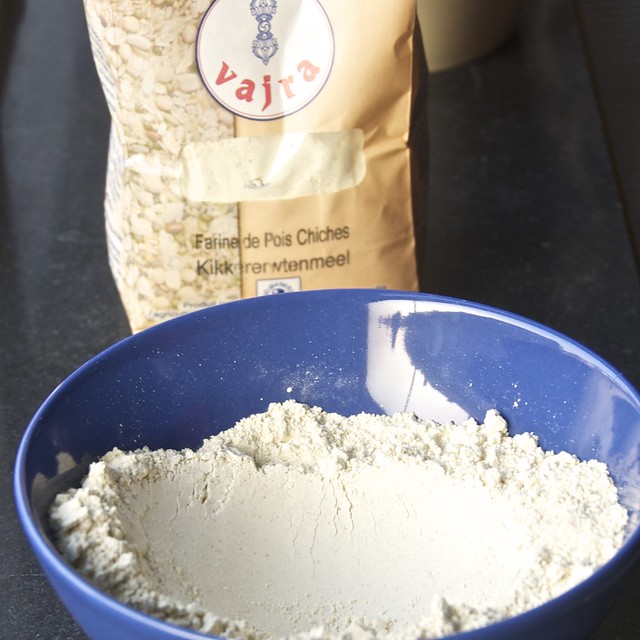
Khadi a chickpea flour and buttermilk soup seasoned with curry leaves, cumin seeds, and turmeric.

Chickpea flour, or besan.
Khadi is a Gujarati soup made out of chickpea flour and buttermilk and seasoned with curry leaves, cumin seeds, and turmeric. It's often served with basmati rice in a thali, or it's served on top of kitchdi. Kitchdi is a rice and lentil dish, where they are both cooked together with minimal seasoning.
Kitchdi and khadi are Guju comfort food for me. Growing up, if we had come home from a trip or vacation, and the fridge needed restocking my parents would serve this; if there was nothing to cook, my parents would cook this; if we got sick, my parents would cook this. This is truly a dish you will not find at any restaurant. It is simple down-home Gujarati cooking, and one I'm sure that is passed on as tradition. Thus, the flavor varies widely, but that is half the fun. This is not a hard dish to make, but it does take a bit of pre-planning in that you need buttermilk, chickpea flour, and a few of the spices. Follow the directions as closely as possible.
Mitta limbda or mitto limdo (basically curry leaves), or cilantro are key in lending and infusing khadi with its distinctive flavor. If you can't find curry leaves, sub in generous amounts of cilantro - honestly as much as you think you'll like, I would go for 1/2 cup chopped. Although most Gujarati cuisine is sweetened with some sugar, my mom's version (and to a much larger extent all of her cooking) lacks unnecessary sugar. The basic flavors of buttermilk, cumin seeds, cilantro, and turmeric really carry this dish.
Khadi
Chickpea flour and buttermilk soup seasoned with curry leaves, cumin seeds, and turmeric.
Serves: 2; recipe by my mom.
Ingredients:
2 tbsp of chickpea flour (such as besan flour) plus 1/3 cup water
1 cup buttermilk (can substitute yogurt)
2 cups water
1 tbsp olive oil
1/2 tsp whole cumin seeds
1/8 tsp udad dhal (optional)
1/8 tsp fenugreek seeds (optional)
pinch asafoetida or hing (optional)
6 curry leaves
2 tbsp chopped cilantro; increase to 1/2 cup chopped cilantro if omitting curry leaves
1/2 - 1 tsp salt, add less if your buttermilk or yogurt is salty
1/4 tsp turmeric
Directions:
Dissolve the chickpea flour in a small amount (approx 1/3 cup) of water in a small mixing bowl large enough to hold 3 cups. Whisk it together (with a whisk) until it is smooth and there are no clumps. Then add the rest of the water and buttermilk. If you don't have buttermilk, yogurt is a fine substitute; in Belgium, I used plattekeis and it was delicious.
Next in a heavy bottom pan, heat up 1 tbsp olive oil (butter or ghee is much better) over medium heat. We're going to do a vaghar (and now you know a word in Guju too). A vaghar is like frying seeds and lentils, and infusing the oil with some of the aromatics from the seeds or lentils. To the oil add in 1/2 tsp whole cumin seeds, 1/8 tsp udad dhal, 1/8 tsp fenugreek, and a pinch of hing or asafoetida. Once the oil begins to get hot, the seeds and lentils will give off a nice fragrance. Don't let them brown too much. If using curry leaves, add them now. They only need a bit of time and you don't want them to brown. Turn the heat to low.
Make sure you turn the heat to low. When everything is simmering, very carefully pour in the buttermilk/chickpea flour mixture. Stir it together well, and then add in cilantro, salt and turmeric. Stir together. Leave a stainless steel spoon in the khadi. This will prevent it from bubbling over. Stay with the khadi. It will overflow if ignored, and then you'll end up with a big mess. Keep an eye on it, stir it frequently. Adjust for salt. The khadi should be done in 20-25 minutes.
Serve, steaming hot, with some plain cooked rice, or kitchdi (recipe will be posted soon), ghee, and papad.

No comments:
Post a Comment